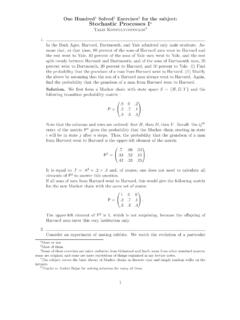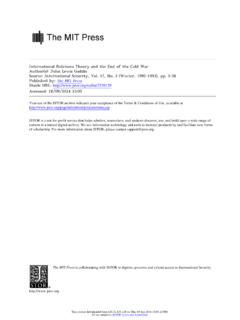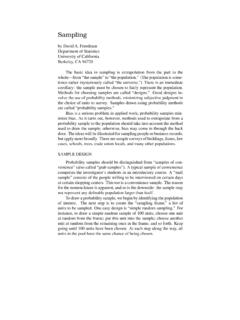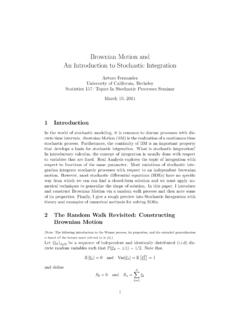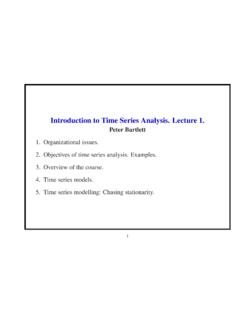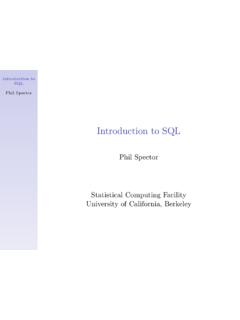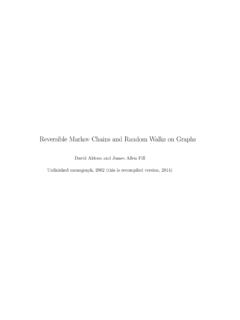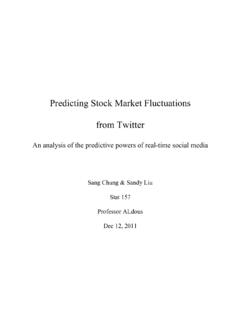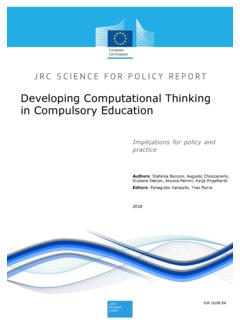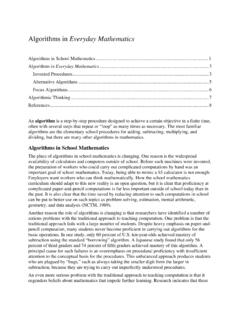Transcription of Computing in the Statistics Curricula
1 Computing in the Statistics CurriculaDeborah NolanBerkeley, CA 94720-3860 Duncan Temple LangDavis, CA 95616 March 15, 2010 AbstractThe nature of Statistics is changing significantly with many opportunities to broaden thediscipline and its impact on science and policy. To realize this potential, our Curricula andeducational culture must change. While there are opportunities for significant change in manydimensions, we focus more narrowly on Computing and call for Computing concepts to be in-tegrated into the Statistics Curricula at all levels. computational literacy and programming areas fundamental to statistical practice and research as mathematics. We advocate that our fieldneeds to define statistical Computing more broadly to include advancements in modern com-puting, beyond traditional numerical algorithms.
2 Information technologies are increasinglyimportant and should be added to the curriculum, as should the ability to reason about compu-tational resources, work with large data sets, and perform computationally intensive tasks. Wepresent an approach to teaching these topics in combination with scientific problems and mod-ern statistical methods that focuses on ideas and skills for statistical inquiry and working withdata. We outline the broad set of computational topics we might want students to encounterand offer ideas on how to teach them. We also discuss efforts to share pedagogical resourcesto help faculty teach this modern Words: computational literacy, curriculum reform, information technology Deborah Nolan is Statistician, Department of Statistics , University of California, 367 Evans Hall MC 3860, Berke-ley, CA 94720-3860, Duncan Temple Lang is Statistician, Department of Statistics , University of California, 4210 Mathematical Sci-ences Building, One Shield Avenue, Davis, CA 95616 The authors grate-fully acknowledge support from the National Science Foundation grants DUE 0618865 and DMS 0636667.
3 Theauthors thank the reviewers for their helpful comments, which led to an improved version of this IntroductionThe main message of this paper is that the digital age is having a profound impact on statisticsand the nature of data analysis, and these changes necessitate revaluation of the training and ed-ucation practices in Statistics . Computing is an increasingly important and necessary aspect of astatistician s work, and needs to be incorporated into the Statistics . Successful statisticians mustbe facile with the computer, for they are expected to be able to access data from various sources,apply the latest statistical methodologies, and communicate their findings to others in novel waysand via new media.
4 In addition, researchers exploring new statistical methodology rely on com-puter experiments and simulation to explore the characteristics of methods as an aid to formalizingtheir mathematical framework. We believe that for the field of Statistics to have its greatest im-pact on policy and science, statisticians must seriously reflect on these major changes and theirimplications for Statistics ability to express statistical computations is an essential skill (analogous to algebra andanalysis/calculus) for practicing data analysts, statistical researchers and students. But, how wellare we, as a community of Statistics educators, preparing our students for this modern era of statis-tics research and practice?
5 Peck and Chance (2007) hail the need for educators to try to find outwhat students are actually learning as they complete the course work for the Statistics major. Theysuggest beginning with an open and frank discussion of the following question: When your stu-dents graduate, what is something observable that you think they ought to be able to do? Wefollow their lead and ask the questions: When they graduate, what ought our students be able todo computationally, and are we preparing them adequately in this regard? Do we provide studentsthe essential skills needed to engage in statistical problem solving and keep abreast of new tech-nologies as they evolve? Do our students build the confidence needed to overcome computationalchallenges to, , reliably design and run a synthetic experiment or carry out a comprehensivedata analysis?
6 Overall, are we doing a good job preparing students who are ready to engage in and2succeed at statistical inquiry? We believe that in general, we fall short of these goals, and call onthe Statistics community to work together, to challenge ourselves and each other, and to make asignificant cultural shift to embrace Computing and integrate it fully into Statistics undergraduatemajor and graduate recent article, What is Statistics ? (Brown and Kass, 2009), calls attention to the chang-ing landscape for the field of Statistics where success requires highly flexible problem-solvingstrategies, yet they observe a worrisome tendency to attack problems using blunt instrumentsand naive attitudes.
7 Brown and Kass attribute part of the problem to our courses and degreeprograms. They point out that historically mathematical thinking influenced both research andinfrastructure in Statistics departments and currently may not be serving the field well. It is reallyimportant that statisticians are beginning to reflect on the changes in the field and how these impacttraining programs. We share many of the same concerns and solutions as described in Brown andKass (2009), and call for the Statistics community to examine the legacy of computational trainingfor statisticians. The skill set needed even 20 years ago for a statistician is very different Three key componentsComputational ability supports statistical inquiry and is vital to all facets of a statistician s , it occupies an astonishingly small proportion of the Statistics Curricula .
8 Many statisticianswould agree that there should be more Computing in the Statistics curriculum and that statisticsstudents need to be more computationally capable and literate. However, it can be difficult to de-termine what specifically to teach and how to practically change the curriculum. In our experiencewith designing and teaching new courses in Computing , the following considerations have come tothe Broaden statistical computingWithin the past five to ten years, an ever larger array of com-puting topics have impacted the work of practicing statisticians and this is only likely to continue3to increase as the Web is used to disseminate data in rich new ways.
9 While the traditional area ofcomputing related to the study of numerical analysis and algorithms for statistical methods (oftenreferred to as computational Statistics ) is still very important to the field, other topics have alsobecome significant, and to different categories of students. Today, and in the future, statisticiansmust access and integrate large amounts of data via Web services and databases, manipulate com-plex data ( text, network graphs) into forms more conducive to statistical analysis, and produceinteresting statistical presentations of data as exemplified by GapMinder (GapMinder Foundation,2008). The importance of these innovations on the access, analysis, and presentation of data, makea strong case for broadening the Statistics curriculum to include these non-traditional Deepen computational reasoning and literacyIn many regards, Computing skills are similarto mathematical skills, which are not important to Statistics in their own right but in how they allowus to reason about and express statistical ideas and techniques.
10 Statistics students, at the major andgraduate levels, must be able to express themselves through computations, understand the funda-mental concepts common to programming languages, and discuss and reason about computationalproblems precisely and clearly. Instruction must move beyond how-to examples, idioms and tem-plates for students to copy. They need to gain explicit experience with programming an algorithmand with programming language concepts such as variables, assignments, flow control, functions,parameters, data structures, input and output, error handling, debugging, and so on. Whether theyenter the workforce from an undergraduate degree in Statistics or enter graduate programs and re-search careers, future statisticians will encounter an ever changing array of current technologies,data formats, and programming languages.
